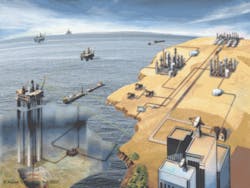Digital Energy Comes of Age
The energy industry is at the start of a renaissance brought about by the rise of national oil companies and countries as primary asset holders, the increased globalization of the energy business and the need to recruit and integrate the best minds from diverse cultures. Like its Sixteenth Century counterpart, this energy renaissance is triggered by lowered barriers to international trade and business, a changing set of geopolitical conditions and technological innovation that creates opportunity for innovative approaches to exploration and production.
One of the most significant innovations involves the integration of information technology - IT - into virtually every aspect of oilfield operations. This coupled with the internet is one of the primary drivers of the energy renaissance, making IT the ‘engine’ behind many of the advancements made in exploration and production technology, not to mention improved world-wide collaboration and communications.
The energy industry continues to deal with an advancing set of challenges, including the following:
- Dealing with more discoveries, which result in the need for bigger and faster models and more processing horsepower and advanced applications to support them.
- Increasing the recovery rate from existing fields, which requires even more complex data sources, including 4-D seismic, improved reservoir models and more accurate control over production through real-time data capture and processing.
- Increasing production through optimization of the rate of production using real-time well and facility modeling. It also includes the increasing use of predictive analytics to reduce down-time, which drives improved visibility of operations.
- Shortening the time to ‘first oil’ through close collaboration with partners, engineering and construction firms, primarily through electronic means.
- Exploiting and producing unconventional hydrocarbon resources cost-effectively.
- Reducing lifting costs through the use of operational models, advanced process control and application integration.
- Improving technical project management in a rapidly accelerating business climate through closer internet-based communications and design application integration.
- Adapting risk management strategies to utilize real-time data more effectively.
- Ensuring the security of business-critical data and communications in an environment where the conditions are constantly changing.
- Dealing with the ‘big crew change’ - making the generational knowledge ‘shift’ that permits continued operations.
Challenges as large as these require all of the resources and creativity that people in the energy industry can muster. As IT continues to evolve and improve, its implementation will continue to increase the value gained from existing resources. But to take best advantage, the industry must be ready to adopt new ways of working that leverage these new technologies through overall process improvement.
Understanding Digital Energy and the Role of Information Technology
Digital Energy is the integration of information and communications technology with processes and data to increase business value. It enhances existing technical domains while imbuing them with the practices of knowledge management/ knowledge reuse and collaboration. It is not simply technology - it’s the direct application of these digital technologies within the E&P process that differentiates Digital Energy from pure IT.
Most managers agree that IT as a business tool has come of age. It is well recognized that IT is included within virtually every aspect of E&P business, and has been for decades. We take for granted the processes by which raw data is transformed into information that can be managed by an end user. We have come to expect that IT will provide support for computations that convert this data to knowledge for technical and business decisions. And we could not work effectively without the balance of the IT suite of tools: email, spreadsheets and the Internet itself.
As essential as IT is to our work processes, often it’s viewed as a cost of doing business - not a way of generating value. Work still remains to be done with helping managers produce the business case that allows companies to ‘connect the dots’ between the perceived commodity IT, the improved business processes and the new value that will be created.
Managing Digital Data: The Essential Role of Digital Energy
In addition to IT, every application of Digital Energy involves the handling and management of digital data. Most companies these days are either ducking or dealing with data issues, in one form or another. Digital technologies provide the only cost-effective way to deal with the mountains of data accumulating throughout an enterprise. Data can be captured from many places, made available through search and geo-reference, then shared and reused. Distilling knowledge from the data - through the capture of expert knowledge, advanced computational analyses, visualization, modeling and predictive analytics - brings value through added insight that’s not able to be easily derived in any other way.
Providing ways to deal effectively with data and derive insight is one important way in which digital technologies help solve E&P problems.
Computing infrastructure continues to advance with the broad availability of high performance Linux clusters, multi-threaded operations, GRID computing and supporting applications. Coupled with cost reductions in processing power and memory, the realm of high performance computing (HPC) is now extending further into operations, to the point where if any process is performance sensitive, an HPC solution is viable. What does this mean to the energy industry? It means that it is now possible to do in minutes and hours what was not possible in days and weeks with earlier generations of hardware. When connected with workflow, this aspect of Digital Energy greatly improves throughput - to the point where people must work smarter and more efficiently as computing infrastructure is no longer the process ‘bottleneck’.
Neither infrastructure improvements nor advancements in data management capabilities will ensure the quality of the data. Companies must have better tools and processes - preferably automated - for ensuring that the data used for making high-value decisions is of the best quality possible. And they must have people with the appropriate skills sets to orchestrate the solution.
Risk Management and Digital Security
The advent of the energy renaissance in the digital age brings a new emphasis on risk management. Traditionally companies have thought of risk as potential physical threats to the health and safety of their employees. Using IT and smart applications definitely helps companies go beyond simple reporting, to where risks can be identified in advance and prevented.
But IT and the digital networks are themselves at risk of attack and intrusion by unwanted parties. And the security of the data must be maintained. A breach can create a huge loss for a company, and the affects can continue for years afterwards. Having a solid digital security plan and infrastructure in place, coupled with the ‘people processes’ to make it work, is necessary to the effective operation of E&P business in this energy renaissance.
New Work Processes Are Essential
Coincident with the energy renaissance, the E&P industry is experiencing the ‘Big Crew Change’. Waves staff reductions during industry downturns over the past 20 years have reduced the number of experienced personnel in mid-career status. As the current senior generation of managers and engineers reaches retirement age, there will not be enough people to oversee and train the ‘next generation’ that is coming into the business. Coupled with the sharp increase in E&P activity, this challenge is forcing companies to seek innovative ways to accelerate the learning curve for their new employees, while achieving maximum productivity from their existing workforce.
This is where IT and Digital Energy can take a leadership role. Workflow with built-in intelligence about a process is taking the place of manual processes. Software tools are becoming more intuitive and easier to use, reducing training time. And the embrace of knowledge management and collaborative technologies are allowing improved knowledge re-use as well as access to expertise within organizations to solve problems.
Through collaboration technologies and processes, E&P workers now have access to the best minds within their organizations. A help desk in Houston may be called upon to provide a direct operational response to a driller in the South China Sea, while capturing that knowledge for use by another driller working in Nigeria. The ability to couple IT with knowledge management capture processes makes it possible to deliver the best knowledge of the organization, anywhere and anytime it is required. This new way of working may be a little alien to the older generation, but the fresh-outs coming into the organization see this as ‘business as usual’ - and will continue to push the boundaries of collaboration, throughout the global enterprise, extending over time to partners and selected experts outside of the company.
People, Process, Technology and the Renaissance Engineer
The energy renaissance requires the embrace of innovation and change as the life-blood of business growth. It also demands that people find new ways of integrating technology into the work environment so that collaboration and knowledge sharing can span global boundaries, with sensitivity for cultural variances. These activities and capabilities converge in the profile of a different kind of energy professional: the “Renaissance Engineer”.
The Renaissance Engineer is a culturally-adept specialist well-versed in the use of IT and knowledgeable in more than one discipline. These people are ‘boundary spanners’, able to work effectively across disciplines and cultures to engage and deliver projects.
Why are they needed? Many of the challenges facing E&P involve the integration of formerly siloed disciplines, in combination with IT. The Renaissance Engineer provides the foundation for cross-discipline teams which address process first for new work activities, supported by appropriate technology. Some of the future Renaissance Engineers may be found in the younger generation of E&P professionals, who are very familiar with IT tools and are increasingly multinational, as recruiting efforts seek to bring in the best people from universities all over the world. And although this title is unlikely to appear on a job description anytime soon, it’s clear that the skill set embodied in the Renaissance Engineer is a crucial part of success in future E&P business activities.


